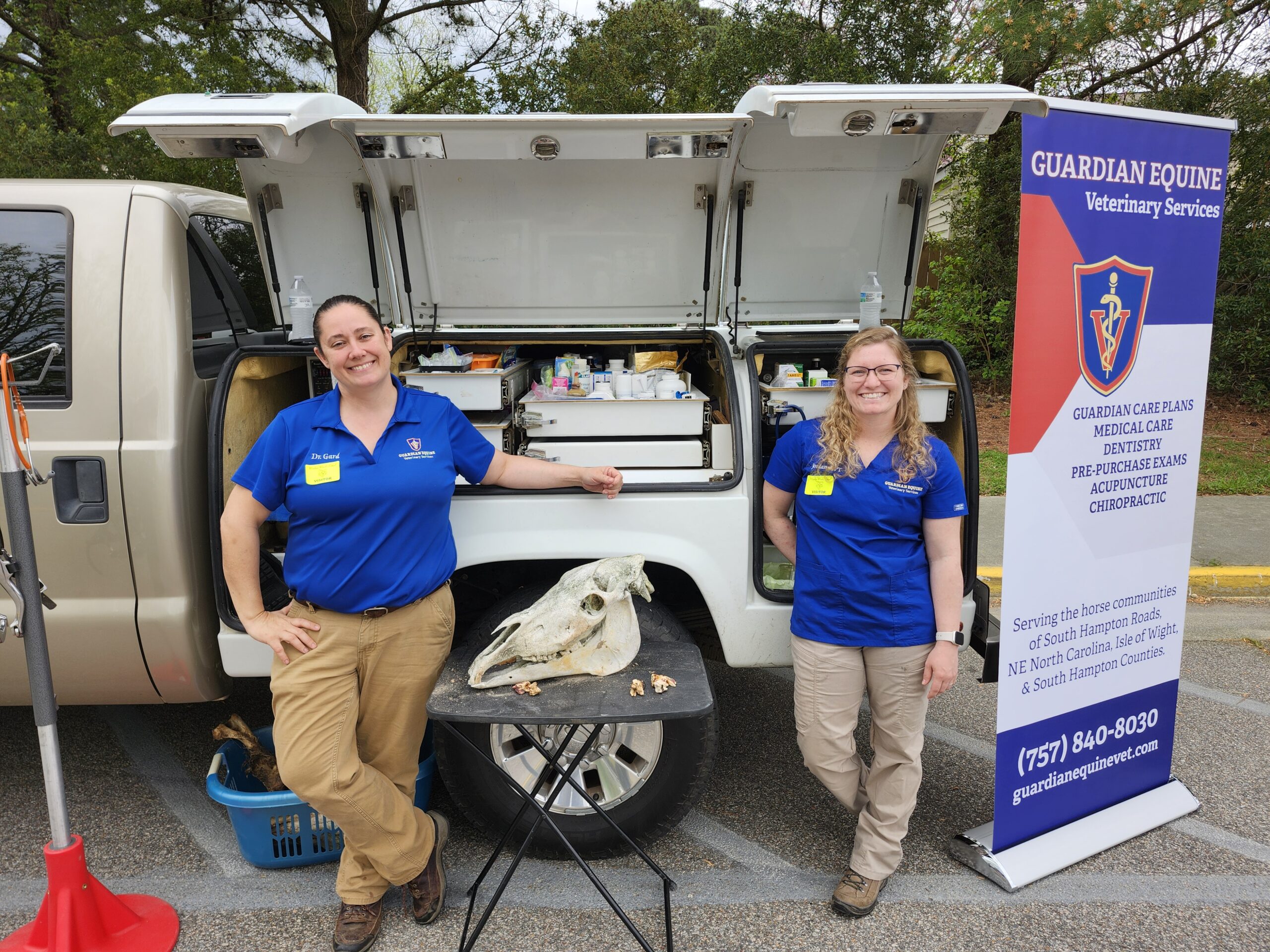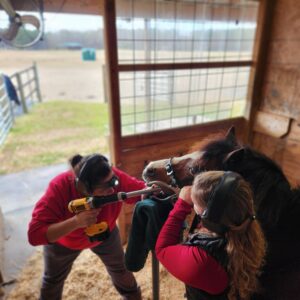This article originally appeared in the Winter 2024 issue of EquiManagement. Sign up here for a FREE subscription to EquiManagement’s quarterly digital or print magazine and any special issues.

If you have an entrepreneurial spirit, prefer to plot your own path, and desire to reap the profits of your hard work, starting your own equine practice will hold great appeal. Having made the decision, you are likely to be seized with an equal mix of excitement and fear. Owning a small business is not an easy task. There are many moving parts and, as the practice owner, you are responsible for keeping everything running smoothly.
Step 1: Determine ‘Who’ Your Equine Practice Will Be
The first step in opening your own practice is thinking about what market you will serve and what differentiates your practice from others in your area. What will set you apart—a certain set of niche skills, such as dentistry or integrative therapy or expertise in lameness diagnosis? Or will it be a cultural difference—will you cater to new horse owners by spending lots of time educating them and caring for their horses as family members? You cannot be all things to all horse owners, so you must choose which owners will be your target market.
Once you have identified who you will serve, think about what those clients need, what they value, and what needs they might have that they aren’t even aware of. Your skills in the technical aspects of veterinary medicine along with your communication and personality should be a smooth fit for your chosen niche. Having decided “who” your practice will be, you should dream about what you would like your practice to become. This is your vision, and it helps you to stay pointed in the right direction, so you arrive at the destination of your dreams. Think about where you are headed regularly and whether it still fits the life you imagine.
Sarah Bye, DVM, cAVCA, started her practice, New Hope Equine, in Bucks County, Pennsylvania, in 2023. “What was truly difficult was creating a vision for my practice, setting boundaries, and sticking to them,” she says. “I had to imagine a career that fit my needs, lifestyle, and interests both within and outside of equine practice and be brave enough to step outside of the traditional equine practice mold to create a sustainable career.”
She says the most surprising thing she discovered was “starting my own practice was far easier than I expected. I registered the business myself, needed minimal startup capital for supplies and inventory, and used social media to quickly spread the word.”
For Sherri Gard, DVM, of Guardian Equine in Virginia, the most exciting thing about starting her own practice was “being my own boss and setting my own standards. I was able to create something that I completely agree with, that is in line with my ethics as well as my standard of practice, and make something that I could be proud of, that I could share with others, to inspire others, and be the change in equine veterinary medicine.”
Step 2: Gather What You Need to Get Started

The next step is determining what equipment and supplies are essential for your first day in practice and what can wait. A practice focused on sport horses will likely need to invest in diagnostic equipment such as a digital X-ray unit and ultrasound immediately, with investment in a shock wave or therapeutic laser to follow. A practice centered on care of “pet” or pleasure horses might be able to postpone those purchases until the practice is on firm financial footing. You will need a vehicle for an ambulatory practice and some kind of veterinary unit in which to organize your equipment. Be as conservative as you can when starting out, especially if you are in an area already saturated with equine veterinarians. It can take time to get established.
“Try to start with as little as possible and pay cash for all that you can,” says Heather Caplan Brass, DVM, of Grand Strand Equine Veterinary Services, in South Carolina. “You don’t have to have the fanciest piece of equipment. Find used or demo models. Don’t forget about the new practice programs from distributors that allow you to divide your opening order through a year.” And remember, it’s a marathon, not a sprint.
Gard says she was surprised by the outpouring of support from the equine veterinary community. “So many people gave me equipment (for free or with huge discounts) to help me start out. I had two separate friends send me oral speculums, both stating, “It’s not the best, but it started me out.’ Neither would take payment, even though I tried! When I upgrade, they will go to the next person starting out. I had a small animal vet send me a used Class III laser with a big price break when she heard I was just getting started. I appreciate each and every one of these gifts and supportive gestures, and I cannot wait to pay it forward as soon as I can.”
Step 3: Brand and Market Your Equine Practice
When naming your practice, think toward the future and the possibility that you might want to grow your practice into something you could sell some day. As Jane Doe, for instance, you might want to reconsider developing a practice called Doe Equine. Build a reputation for excellence with a practice name that’s not your name as an individual. You might use a geographic reference like North Country Equine, a cultural reference like Compassion Equine, or a service reference like Tri-State Equine Dentistry.
Once you have a name, consider launching an online logo design contest. For a minimal amount of money, you can have multiple logos generated from which to choose. Then, use your logo liberally to cement your brand in clients’ and potential clients’ minds. It is also helpful to have a phrase or tagline that describes your practice concisely and can be used on marketing materials. Examples include “Care, compassion, and excellence” or “In sickness and in health.”
To market your new company, you will want to be present on social media, develop a professional-looking website, and keep an active practice Facebook page. Consider doing educational seminars in partnership with local feed companies to get you and your business name in the public eye. Being featured in your local daily or weekly newspaper as a new business is another strategy. Making an appearance at local horse events and competitions with your practice vehicle, ready to provide care, is another way to get noticed. Volunteer to do an educational event for your local 4-H, Pony Club, or high school rodeo team.
Step 4: Form a Business Entity
Other decisions include choosing a business form for your company. Each state has different laws about business entities, so it is best to engage an attorney to help you navigate this step. Forming an LLC or PLLC is often the most simple and advantageous form. Advice from an accountant is also critical at this juncture. Getting these two professionals on your team from Day 1 can help ensure your financial books and business entity are compliant with state and federal laws from the outset and that you minimize your tax liability.
QuickBooks bookkeeping and accounting software is simple to learn and commonly used among accounting professionals. Taking a short course to learn how to use this program will allow you to utilize its many features more efficiently. The more you can learn about business management, the more comfortable you will be as a practice owner.
As your business sees its first clients and patients, think carefully about your policies and procedures. It’s best to commit them to writing. And remember to train your clients “right” from the start, including collecting payment at the time of service.
Final Words of Advice
Bye says one of the best pieces of advice she received when starting her own practice was that “being a solo practitioner doesn’t mean I have to go it alone. I was told to reach out to other local practitioners to build collegial and supportive relationships. We formed an emergency co-op, we discuss cases, and we refer clients to each other. Additionally, I joined a Decade One group, which has given me the support and knowledge to succeed as a business owner.”
“This is the most exciting and most rewarding and most terrifying adventure—all at the same time,” says Gard. “It’s not for everyone. I get that. Some people are meant to be associates, and they thrive in those positions. But for those contemplating practice ownership, with the mentality and fortitude to follow through, it is the best decision you will ever make.”
She relayed a piece of advice a good friend told her: “It is never ‘the right time.’ You will always find an excuse why it’s not the right time or that you can’t do it. Is there really ever a ‘right time’ for huge life changes? No. But you have to take the leap sooner or later. And sooner is better … just take the leap. And I will send you an oral speculum as soon as you do!”
In encouragement to those considering this major life decision, Bye says, “Having your own practice gives you the freedom to create a schedule that fits your needs, practice medicine that matches your standard of care, and cultivate clientele that respect your boundaries. All of this and you earn more doing it. Who wouldn’t want that?”
Although starting your own business is a leap of faith, good planning and careful execution will help you be successful. By seeking out business education, utilizing professional advisors, having a clear mission and vision for your practice, and developing appropriate boundaries, you can start your own practice and thrive.
Related Reading
- Tides of Change: Equine Veterinarian Retention
- The Business of Practice: Starting Your Own Equine Practice
- The Business of Practice: Hiring an Equine Practice Associate
Stay in the know! Sign up for EquiManagement’s FREE weekly newsletters to get the latest equine research, disease alerts, and vet practice updates delivered straight to your inbox.

![[Aggregator] Downloaded image for imported item #18711](https://s3.amazonaws.com/wp-s3-equimanagement.com/wp-content/uploads/2025/10/20105749/EDCC-Unbranded-14-scaled-1-768x512.jpeg)


